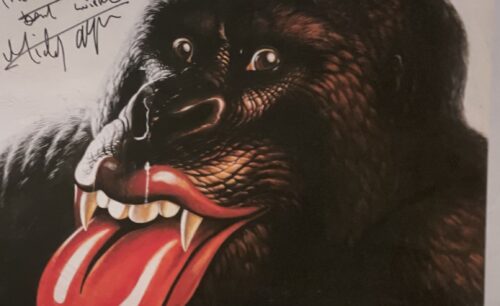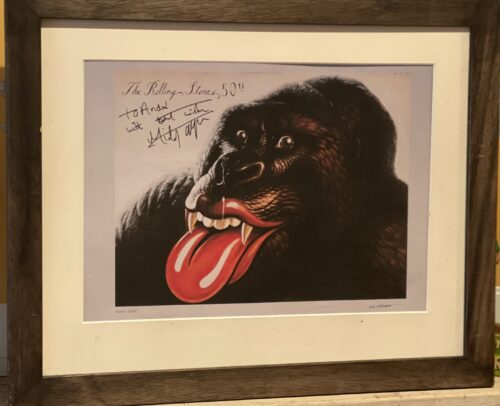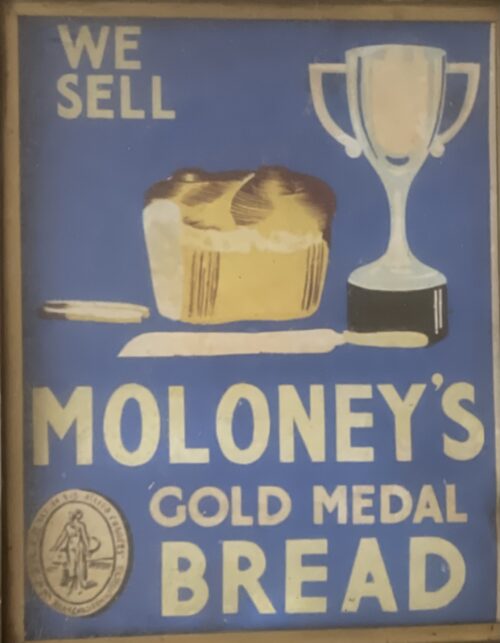-

 Art and craft classes were held at the Maze,Long Kesh Prison & prisons in the South as part of educational programmes, some by the prison authorities and some by the prisoners themselves. Prisoners could gain qualifications and formal courses in art history were also offered. In addition, arts and crafts were pursued at an informal level within the prison. Murals were painted on the walls of both the H-Blocks and the Nissen huts within the cages/ compounds. Handicrafts made in the prison could be sold on the ‘outside’, with proceeds going to prisoners’ families. In 1996 the Prison Arts Foundation (PAF) was founded, with the aim of providing access to the arts for all prisoners, ex-prisoners, young offenders and ex-young offenders in Northern Ireland. During the latter years of the Maze and Long Kesh Prison, the PAF promoted access to the arts by organising professional artist residencies and workshops in the H-Blocks. Security considerations placed constraints on materials permitted and the type of art and crafts that could be produced in the prison. For example, glass and ‘inflammable’ paint were not allowed. However, the availability of tools and materials varied across the site and over the years. And prisoners also improvised with materials to hand.
Art and craft classes were held at the Maze,Long Kesh Prison & prisons in the South as part of educational programmes, some by the prison authorities and some by the prisoners themselves. Prisoners could gain qualifications and formal courses in art history were also offered. In addition, arts and crafts were pursued at an informal level within the prison. Murals were painted on the walls of both the H-Blocks and the Nissen huts within the cages/ compounds. Handicrafts made in the prison could be sold on the ‘outside’, with proceeds going to prisoners’ families. In 1996 the Prison Arts Foundation (PAF) was founded, with the aim of providing access to the arts for all prisoners, ex-prisoners, young offenders and ex-young offenders in Northern Ireland. During the latter years of the Maze and Long Kesh Prison, the PAF promoted access to the arts by organising professional artist residencies and workshops in the H-Blocks. Security considerations placed constraints on materials permitted and the type of art and crafts that could be produced in the prison. For example, glass and ‘inflammable’ paint were not allowed. However, the availability of tools and materials varied across the site and over the years. And prisoners also improvised with materials to hand. -

 26cm (empty)
26cm (empty)Bunratty Mead is a traditional wine, produced from an ancient Irish recipe of pure honey, fruit of the vine and natural herbs. It's a medium sweet wine, with a wide taste appeal, and suitable for all important occasions. As the drink of the ancient Celts, Mead derives much of its appeal through Irish Folklore, which is legendary of this mystical drink with strong attachments to Ireland.
In the days of old when knights were bold, the drink of choice was mead. Much more than an extraordinary legendary drink with strong attachments to Ireland, mead can be traced back as many centuries before Christ. It became the chief drink of the Irish and was often referred to in Gaelic poetry. Mead's influence was so great that the halls of Tara, where the High Kings of Ireland ruled, were called the house of the Mead Circle. Its fame spread quickly and soon a medieval banquet was not complete without it.


Even the church recognised the value of this fabulous drink. Legend has it that St. Finian lived for six days a week on bread and water, but on Sundays ate salmon and drank a full sup of mead. In addition, St. Bridget performed a miracle when mead could not be located for the king of Leinster. She blessed an empty vessel, which miraculously filled with Mead.

-
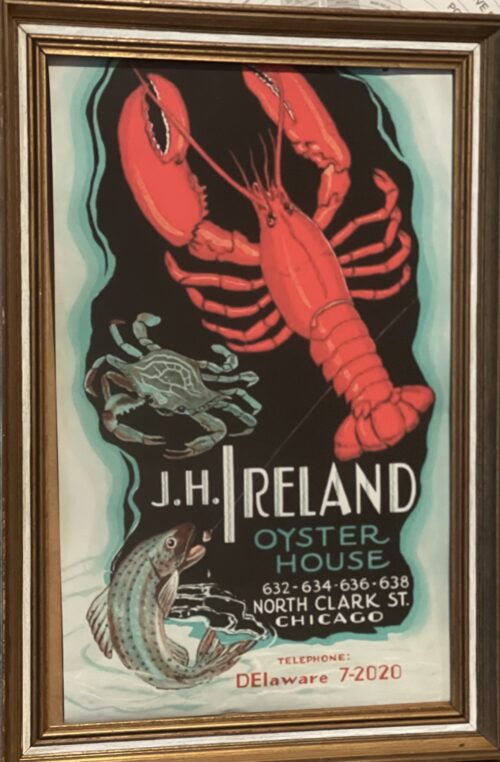
 72cm x 46cm The original J. H. Ireland Grill Room opened in Chicago in 1906, and was one of the windy city's best loved restaurants. Proprietor Jim Ireland expanded the property over two decades, adding a Lobster Grotto, a Marine Room and a banqueting hall modeled after the saloon of a passenger ship. The infamous gangster John Dillinger often dined at J. H. Ireland - he liked the frog legs - and famed attorney Clarence Darrow ate a victory dinner at the restaurant at the end of the famous Leopold and Loeb murder trial. This 1940s menu cover by folk artist Charles Jerred, in wonderfully vibrant shades of green and red, showcases what was one of Chicago's best loved restaurants and is a Love Menu Art best seller.
72cm x 46cm The original J. H. Ireland Grill Room opened in Chicago in 1906, and was one of the windy city's best loved restaurants. Proprietor Jim Ireland expanded the property over two decades, adding a Lobster Grotto, a Marine Room and a banqueting hall modeled after the saloon of a passenger ship. The infamous gangster John Dillinger often dined at J. H. Ireland - he liked the frog legs - and famed attorney Clarence Darrow ate a victory dinner at the restaurant at the end of the famous Leopold and Loeb murder trial. This 1940s menu cover by folk artist Charles Jerred, in wonderfully vibrant shades of green and red, showcases what was one of Chicago's best loved restaurants and is a Love Menu Art best seller. -

 65cm x 45cm Nun's Island Distillery was an Irish whiskey distillery which operated in Galway, Ireland, from at least 1815, and possibly as early as the late 1700s, until circa 1908. At its peak, in the late 1800s, output at the distillery reached 400,000 gallons per annum, and with a workforce of over 100, the distillery was one of the largest local employers. Owned by the Persse family from the 1840s onwards, the distillery produced single pot still whiskey known as Persse's Galway Whiskey. The whiskey was sold locally in Connacht, where for much of the 1800s, Nun's Island was the only licensed distillery.However, it was also exported, and is said to have been a sold to the British House of Commons, a fact proudly noted on their labels. Production at the distillery ceased circa 1908, with the remaining stocks wound down off over several few years. A bottle of Persse's whiskey was placed for auction in 2002 with a reserve price of £100,000 - however, it failed to sell. The bottle later sold for £3,300 in 2014.
65cm x 45cm Nun's Island Distillery was an Irish whiskey distillery which operated in Galway, Ireland, from at least 1815, and possibly as early as the late 1700s, until circa 1908. At its peak, in the late 1800s, output at the distillery reached 400,000 gallons per annum, and with a workforce of over 100, the distillery was one of the largest local employers. Owned by the Persse family from the 1840s onwards, the distillery produced single pot still whiskey known as Persse's Galway Whiskey. The whiskey was sold locally in Connacht, where for much of the 1800s, Nun's Island was the only licensed distillery.However, it was also exported, and is said to have been a sold to the British House of Commons, a fact proudly noted on their labels. Production at the distillery ceased circa 1908, with the remaining stocks wound down off over several few years. A bottle of Persse's whiskey was placed for auction in 2002 with a reserve price of £100,000 - however, it failed to sell. The bottle later sold for £3,300 in 2014.History
The early history of the distillery is somewhat difficult to piece together.It is known that a distillery on Nun's Island was being operated on by a John Joyce in the late 1700s.This distillery, which was subsequently taken over by Patrick Joyce, is thought to have ceased operations in 1807. A Patrick Joyce is recorded as running a small distillery on Nun's Island again in 1823. Therefore, it is possible that the closure was temporary. By 1828, output at the distillery had increased to 130,000 proof gallons per annum. There are claims that the distillery ceased operations again in the late 1830s.However, a newspaper advertisement from 1841 reports that a distillery "lately occupied and worked" by Messrs. James and Patrick Joyce was to be sold on 4 February 1841. The advertisement noted that the distillery was held under a 300-year lease, which had commenced in August 1815.This tallies with Alfred Barnard's 1887 report that Joyce's owned the distillery from 1815 to 1840. In about 1840 or 1841, the distillery was purchased by the Persses, a local family who ran several other distilleries in the area.There is some conflicting information with regard to the precise and nature of the sale date. Barnard reported that the distillery was sold by the Encumbered Claims Courts in 1840.However, a newspaper article from the era reports that the distillery was to be sold by private contract in February 1841. As Barnard mentions that the Persses enlarged the original operation, the confusion may be due to piecemeal purchases of different sections of the site, or delays in finalising the sale as the distillery had been repeatedly advertised for sale beginning in at least early 1840. Initially the Persses converted the distillery to a woollen mill, which was known for producing excellent friezes. However, when their lease on the nearby Newcastle Distillery expired in 1846, they moved their distilling operations at the Nun's Island complex, and re-established the site as a distillery. In 1886, the distillery was visited by British historian Alfred Barnard, as recounted in his seminal publication "The Whiskey Distilleries of the United Kingdom". Barnard noted that at the time of his visit Nun's Island was the sole distillery operating in Connacht, and had an output of about 400,000 gallons per annum. In addition to offices, workshops, stables, and storehouses, the distillery buildings included two lofty Maltings and Corn stores built of stone, five storeys of which were devoted to the storing of corn, and two to malting purposes; an elegant brew house equal to any in Ireland; a back house containing thirteen washbacks, each with a capacity of about 18,000 gallons; a still house containing a 16,000 gallon wash still, a 10,000 gallon spirit still, and a 6,000 gallon low-wines still; a spirit store occupied by a 12,000 gallon vat; and five warehouses, holding a total of about 5,000 casks at the time. Like many other Irish distilleries, Nun's Island encountered financial difficulties during the early part of the 20th Century, is thought to have closed shortly before World War I. Since closing, some of the distillery complex has been demolished. However, several of the main distillery buildings, notably the large riverside warehouse, are still extant. -
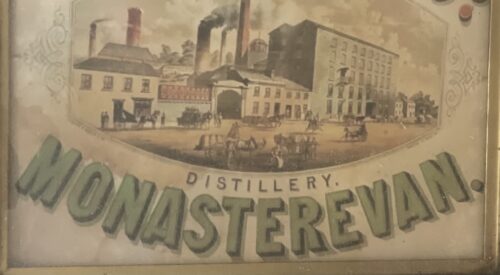
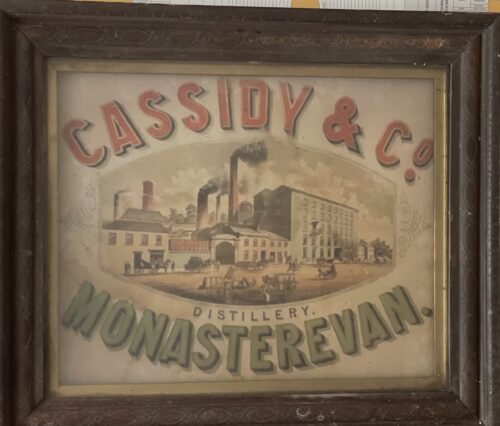 67cm x 56cm
67cm x 56cmIn 1784 Monasterevin Distillery was opened by Mr. John Cassidy. A hundred years later, in 1884 the distillery was making 250,000 gallons of whiskey a year. It was said that the "Cassidy whiskey was the best whiskey in the country".
Some of the whiskey was exported to London. It was transported to Dublin on canal boats and then shipped to England from Dublin Port. A brewery for making beer was later opened in 1860. Cassidy's Distillery and Brewery closed in 1934.
The Cassidy Family lived in Monasterevin House. They were friendly with Gerard Manley Hopkins, the famous poet. He stayed with them when he visited Monasterevin.
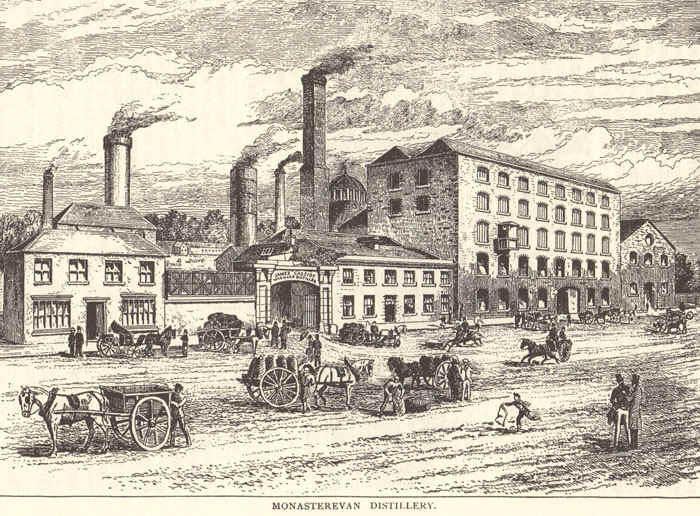
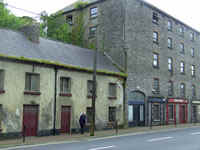
-
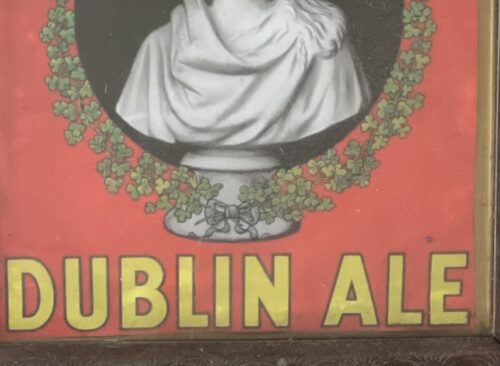
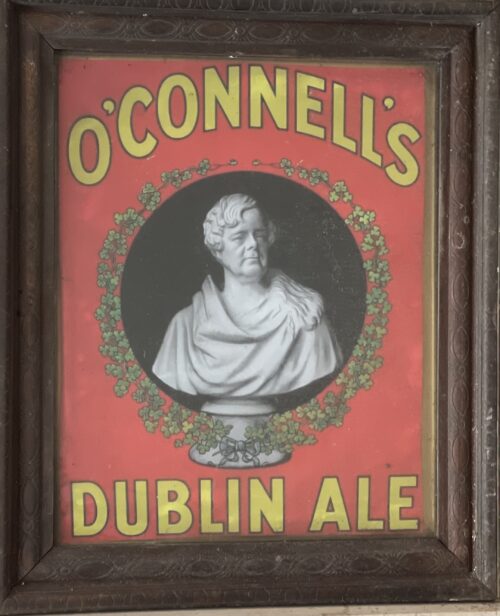 67cm x 56cm
67cm x 56cmDaniel O’Connnell Jr. had famously acquired the Phoenix Brewery in James’s street in 1831, which produced O’Connell’s Ale. It should be noted that O’Connell and the Guinness family were at times political rivals, something best captured by the 1841 ‘Repeal Election’, where O’Connell had stood against and defeated Arthur Guinness Jr. This period would see a sizeable boycott of Guinness, dubbed “Protestant Porter” by sections of the populace, though this was against the wishes of O’Connell himself.
John D’Arcy continued to brew O’Connell Ale after the family had ceased their role in brewing, and in time production moved to the Anchor Brewery in Usher Street. Watkins eventually took up the brewing of O’Connell Ale, and this advertisement was placed by them in the pages of leading newspapers in the 1930s.
While Arthur had failed to defeat O’Connell at the Ballot Box, I always wonder what O’Connell would think of the Guinness Empire today every time I see a Diaego truck pass his statue.
-
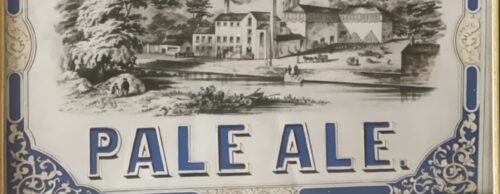
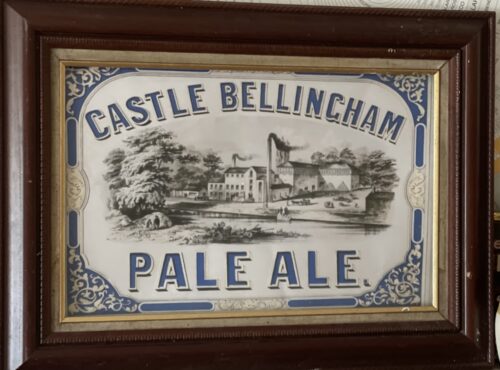 74cm x 52cm ANOTHER great industry on the Scotch Hall site was the brewing firm of Cairnes Ltd, one of the original firms of Irish brewers dating back to 1772 with the foundation of the Castlebellingham Brewery at the picturesque Co Louth village of that name.In 1825, William Cairnes, who was related by marriage to the owners of the ’Bellingham brewery, founded the brewery at Marsh Road, Drogheda, which, for over 150 years, gave employment to almost 200 workers and the firm was famous for its ales and stout. In 1889 the interests of the two breweries were pooled, a public company being formed under the title of the Castlebellingham and Drogheda Breweries Ltd. This title was changed for brevity in 1933 to Cairnes Ltd. For a good many years subsequent to the merger, the breweries were worked independently, each supplying its own customers throughout Ireland and abroad. However, in 1923, it was considered advisable to concentrate brewing in Drogheda, owing to the more advantageous position of the town, and the brewing plant and premises there, were more extensive. Actually the plant at Drogheda was one of the most up-to-date in Ireland and compared very favourably with that of breweries in England and Wales. The supply of brewing water was obtained from a 400ft deep artesian well on the company’s premises. (I wonder if it is still there) and this water was used with the choicest hops and malt made from the best Irish barley obtainable. The hops used came chiefly from Kent and when obtainable, a percentage came from the USA. The process through which the barley went from its arrival in the brewery until it emerged as ale or stout, was extremely interesting and quaint. The barley was first dried to a consistent level of moisture content and then stored for a few weeks before being steeped. It was then ‘floored’ on lots which the brewery had, as well as lofts in Dominic Street and Wellington Quay. These have, in recent years, been converted into shops and a high rise apartment block. Here on these lofts the growing process of the barley in the ground was artificially repeated, the growth however being terminated at the desired stage. The barley was then kilned and cured before being ground and mashed with hot water and the liquid was drawn off. It was then run to built-in coppers, where hops was added, then boiled, the wort, as it was called, being subsequently strained from the hops, cooled and fermented. The final stage was when the beer was casked (in wooden barrels) and matured. Altogether there were approximately 200 people employed in the industry, for apart from the actual brewing of the beer there was a tremendous amount of activity, and the transport department built up a fine fleet of steam lorries, (I remember seeing Gerry McConville driving one of these down the Marsh Road), motor lorries and carts and Jemmy Early was in charge of town deliveries in a horse drawn wagon, from which he rolled the barrells into the pub. While catering for an extensive home market, Cairnes Ltd had, since May 1951, been engaged in the export of bottled stout to America. This stout was much stronger than anything of its kind on sale in Ireland and the venture steadily expanded in the new market. The metal caps of the export bottles had the imprint of the Star and Crescent, which is part of the Drogheda Coat of Arms, while the label carried three reproductions of miniature photographs of St Laurence Gate. And so one of Drogheda’s oldest industries was carrying the name of the town across the world. In Millmount museum there is a permanent exhibition of artifacts from Cairnes Brewery which were literally ‘rescued’ before and during the closing down of the brewery in 1965 when Guinness started buying out their competitors.Showcased are the various bottles with their beer labels – the famous ‘Stingo’, a most favoured ale at the time. There are also the large enamel advertising signs with ‘W Cairnes and Son. X Porter’ showing the brewery in its heyday, and a complete set of tools which were used by the cooper (wooden barrel maker), with a mythology of names like, the adze, draw knife, the buzz, the auger and chisel, the spokeshave and the coopers anvil. Note: A recent informant who wishes to remain anonymous, wrote the following about Cairnes Brewery: ‘The last brew was carried out in October 1960. The brew was mashed by Joseph Oliver Roche, head brewer and declared by Patrick (Paddy) Weldon. ‘In the break-up of the Brewery by Guinness, Roche was sent to Waterford, while Weldon was sent to Dundalk. Kevin Beatty was also sent to New Ross or was it Enniscorthy?’
74cm x 52cm ANOTHER great industry on the Scotch Hall site was the brewing firm of Cairnes Ltd, one of the original firms of Irish brewers dating back to 1772 with the foundation of the Castlebellingham Brewery at the picturesque Co Louth village of that name.In 1825, William Cairnes, who was related by marriage to the owners of the ’Bellingham brewery, founded the brewery at Marsh Road, Drogheda, which, for over 150 years, gave employment to almost 200 workers and the firm was famous for its ales and stout. In 1889 the interests of the two breweries were pooled, a public company being formed under the title of the Castlebellingham and Drogheda Breweries Ltd. This title was changed for brevity in 1933 to Cairnes Ltd. For a good many years subsequent to the merger, the breweries were worked independently, each supplying its own customers throughout Ireland and abroad. However, in 1923, it was considered advisable to concentrate brewing in Drogheda, owing to the more advantageous position of the town, and the brewing plant and premises there, were more extensive. Actually the plant at Drogheda was one of the most up-to-date in Ireland and compared very favourably with that of breweries in England and Wales. The supply of brewing water was obtained from a 400ft deep artesian well on the company’s premises. (I wonder if it is still there) and this water was used with the choicest hops and malt made from the best Irish barley obtainable. The hops used came chiefly from Kent and when obtainable, a percentage came from the USA. The process through which the barley went from its arrival in the brewery until it emerged as ale or stout, was extremely interesting and quaint. The barley was first dried to a consistent level of moisture content and then stored for a few weeks before being steeped. It was then ‘floored’ on lots which the brewery had, as well as lofts in Dominic Street and Wellington Quay. These have, in recent years, been converted into shops and a high rise apartment block. Here on these lofts the growing process of the barley in the ground was artificially repeated, the growth however being terminated at the desired stage. The barley was then kilned and cured before being ground and mashed with hot water and the liquid was drawn off. It was then run to built-in coppers, where hops was added, then boiled, the wort, as it was called, being subsequently strained from the hops, cooled and fermented. The final stage was when the beer was casked (in wooden barrels) and matured. Altogether there were approximately 200 people employed in the industry, for apart from the actual brewing of the beer there was a tremendous amount of activity, and the transport department built up a fine fleet of steam lorries, (I remember seeing Gerry McConville driving one of these down the Marsh Road), motor lorries and carts and Jemmy Early was in charge of town deliveries in a horse drawn wagon, from which he rolled the barrells into the pub. While catering for an extensive home market, Cairnes Ltd had, since May 1951, been engaged in the export of bottled stout to America. This stout was much stronger than anything of its kind on sale in Ireland and the venture steadily expanded in the new market. The metal caps of the export bottles had the imprint of the Star and Crescent, which is part of the Drogheda Coat of Arms, while the label carried three reproductions of miniature photographs of St Laurence Gate. And so one of Drogheda’s oldest industries was carrying the name of the town across the world. In Millmount museum there is a permanent exhibition of artifacts from Cairnes Brewery which were literally ‘rescued’ before and during the closing down of the brewery in 1965 when Guinness started buying out their competitors.Showcased are the various bottles with their beer labels – the famous ‘Stingo’, a most favoured ale at the time. There are also the large enamel advertising signs with ‘W Cairnes and Son. X Porter’ showing the brewery in its heyday, and a complete set of tools which were used by the cooper (wooden barrel maker), with a mythology of names like, the adze, draw knife, the buzz, the auger and chisel, the spokeshave and the coopers anvil. Note: A recent informant who wishes to remain anonymous, wrote the following about Cairnes Brewery: ‘The last brew was carried out in October 1960. The brew was mashed by Joseph Oliver Roche, head brewer and declared by Patrick (Paddy) Weldon. ‘In the break-up of the Brewery by Guinness, Roche was sent to Waterford, while Weldon was sent to Dundalk. Kevin Beatty was also sent to New Ross or was it Enniscorthy?’ -
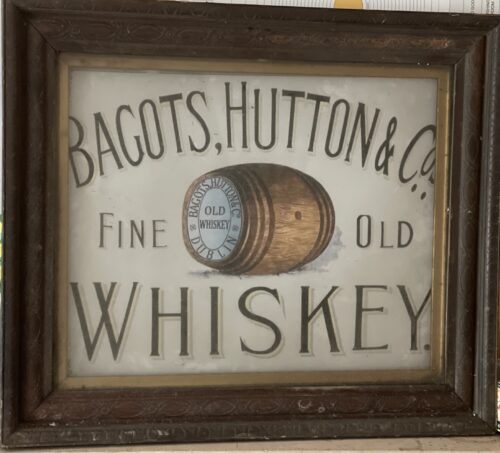
 68cm x 56cmWith a history dating back generations it is inevitable that many myths and legends about Kinahans whiskey steeped into storytelling. But the origins of the L.L. mark have been well documented. In 1807, the Lord Lieutenant of Ireland (the head of state), Charles Lennox, was so impressed with the whiskeys made by Kinahans that he ordered all stocks at the Kinahans Dublin vaults to be taken exclusively for his private use, marking each cask with “L.L.”. The news, which were highly advertised, led to Kinahans becoming one of the most sought after whiskeys both, domestically and in neighbouring countries.In 1819, the popularity of the Kinahans brand allowed to set up its own four story headquarters, at the corner of Burgh Quay and D’Olier Street, Dublin, Named the Carlisle Building, to resonate with nearby Carlisle Bridge, the premises were built as part of the re-development of the city being overseen by the city's Wide Street Commissioners. By the middle of 20th Century the historic building has been taken down.As Kinahans popularity grew, London became a natural base for the company in 1800s wishing to expand into international markets. On 31 December 1841, Kinahans appointed Mr. George Smyth as its first agent in the city of London, with an address at no.1 White Hart Court, London, UK. For over half a century the company's London base has formed the centre of a great volume of export trade to the Continent, China, India, Australia and all the foreign markets.
68cm x 56cmWith a history dating back generations it is inevitable that many myths and legends about Kinahans whiskey steeped into storytelling. But the origins of the L.L. mark have been well documented. In 1807, the Lord Lieutenant of Ireland (the head of state), Charles Lennox, was so impressed with the whiskeys made by Kinahans that he ordered all stocks at the Kinahans Dublin vaults to be taken exclusively for his private use, marking each cask with “L.L.”. The news, which were highly advertised, led to Kinahans becoming one of the most sought after whiskeys both, domestically and in neighbouring countries.In 1819, the popularity of the Kinahans brand allowed to set up its own four story headquarters, at the corner of Burgh Quay and D’Olier Street, Dublin, Named the Carlisle Building, to resonate with nearby Carlisle Bridge, the premises were built as part of the re-development of the city being overseen by the city's Wide Street Commissioners. By the middle of 20th Century the historic building has been taken down.As Kinahans popularity grew, London became a natural base for the company in 1800s wishing to expand into international markets. On 31 December 1841, Kinahans appointed Mr. George Smyth as its first agent in the city of London, with an address at no.1 White Hart Court, London, UK. For over half a century the company's London base has formed the centre of a great volume of export trade to the Continent, China, India, Australia and all the foreign markets.
The Royal Warrants

1845
Throughout 1800s Kinahans continued to offer the highest level of differentiated taste and craftsmanship, for which Queen Victoria awarded it a Royal Warrant in 1845. With major accolades in hand, the recruitment of the agents and retail outlets continued.
The Preferred Whiskey Of Jerry Thomas

1862
With popularity in the British Isles, by the middle of 19th century Kinahans whiskey came to be the notice of many American authors and connoisseurs. In 1860s Kinahans came to the attention of the legendary Jerry Thomas. Also known as "the father of American mixology", Jerry Thomas was a revolutionary character, who due to his creativity and showmanship transformed the image of the bartender as a creative professional. In his 1862 "Guide on How to Mix Drinks", Jerry Thomas featured Kinahans in one of his book's recipes. The Bartender's "Guide on How to Mix Drinks" was the first drinks and mixology book ever published in the United States and can be counted amongst very few most influential drinks publications to date.
Protected Trademark

1863
Since its rise to popularity Kinahans faced hazardous times. Because of the brand's accolades, unscrupulous merchants publicans and others were restless in using the Kinahans bottles, labels and brand marks in order to sell their own products. In 1863, the activities of William Bolton, a grocer in Dublin's Westmoreland Street, led to the final and landmark case of legal redress. In the Irish case of Kinahan v. Bolton, the Irish Courts granted an injunction to restrain others from invading the Kinahans L.L. mark.
A Household Name

1881
The terms “Kinahans” and “Kinahans L.L.” is by 1881 a household name, becoming widely accepted as shorthand for a whisky of a specific price, quality and reputation. Confirmation for this is found in the 1881 Edition of Brewer's Dictionary of Phrases and Fables, in which the origin of L.L. trademark is also described. It is against this background that familiarity with the Kinahans brand name found expression in books written by countless British and American authors.
Decline Of The Irish Whiskey Industry
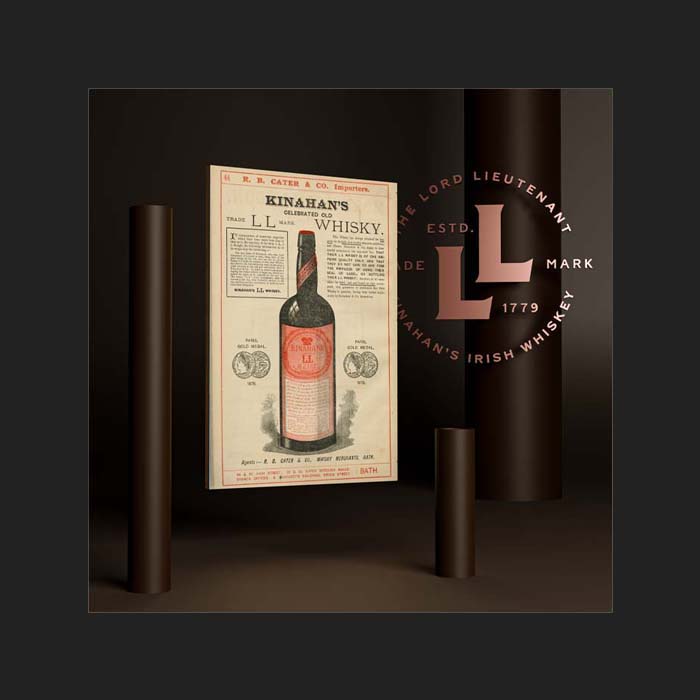
1902-1911
The new century began favourably. However, nothing could shield the company from the tribulations that were about to unfold. One of the key family members, George Kinahan died in 1903 and with him ended the family's long association with Dublin civic life as well as the prestige and opportunities which would have created. As the longest serving director, he took with him an intimate knowledge of the company's history as well as a wealth of practical business experience. Additionally, his long directorship at the Bank of Ireland would also have been of great practical value, not least because at various times his fellow directors at the bank included senior members of the Jameson whiskey family. On top of the departure of George Kinahan, the company had to cope with changing and more difficult economy in Ireland. Overall Irish whiskey exports declined spectacularly between 1900 and 1914. In Ireland itself both consumption and production fell, aided by increase of almost a third in spirit duty, as proposed by Lloyd George in his 1909 budget.
Transfer Of The Brand
 In June 1911 Kinahans business operations were being transferred to Bagot & Hutton, another long established Dublin wine and spirit enterprise. This company bottled and distributed Kinahans L.L. whiskey up until the time of Prohibition in the United States in 1920.In November 1920, following the Prohibition in the United States, an economic decline and a forthcoming Civil War in Ireland, the two spirit houses combined and were registered as Bagot Hutton & Kinahan. This arrangement continued until October 1988, when the shareholders decided to take a long break for one of Dublin's most prominent business houses, until better times.
In June 1911 Kinahans business operations were being transferred to Bagot & Hutton, another long established Dublin wine and spirit enterprise. This company bottled and distributed Kinahans L.L. whiskey up until the time of Prohibition in the United States in 1920.In November 1920, following the Prohibition in the United States, an economic decline and a forthcoming Civil War in Ireland, the two spirit houses combined and were registered as Bagot Hutton & Kinahan. This arrangement continued until October 1988, when the shareholders decided to take a long break for one of Dublin's most prominent business houses, until better times.

